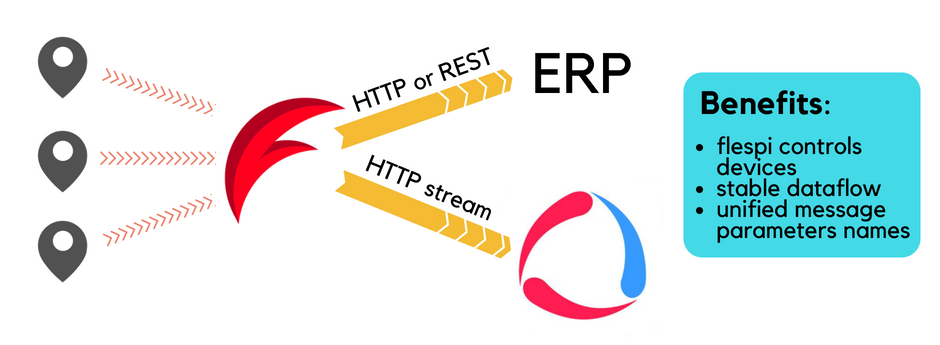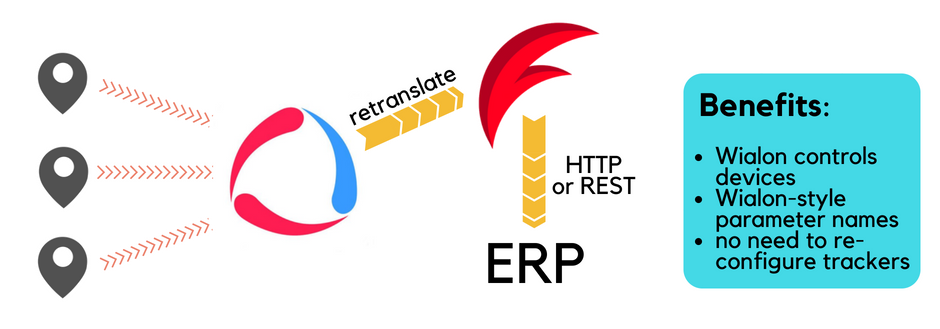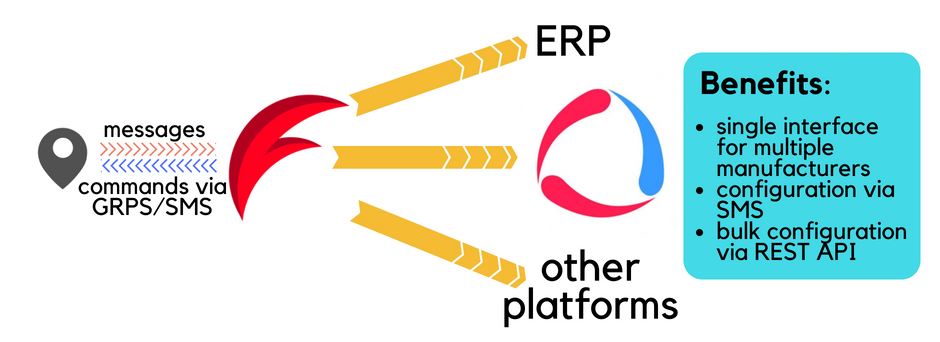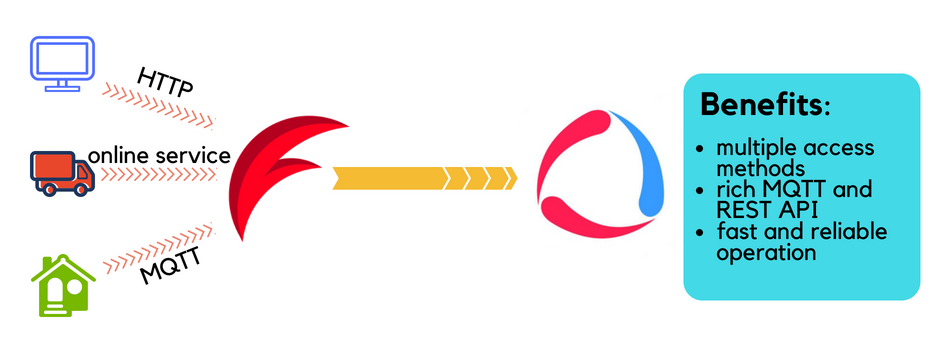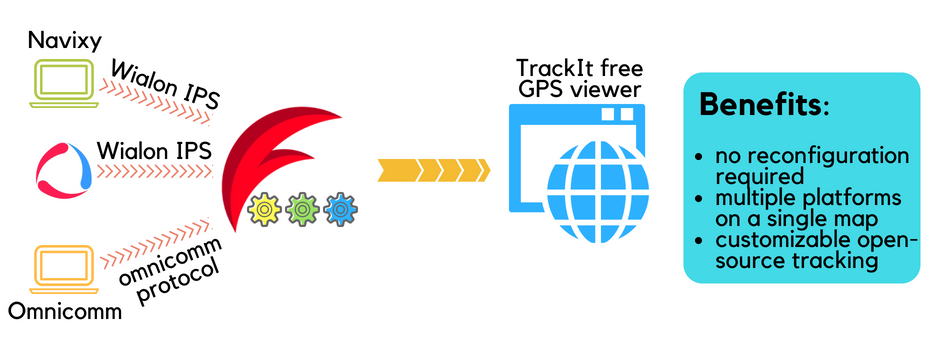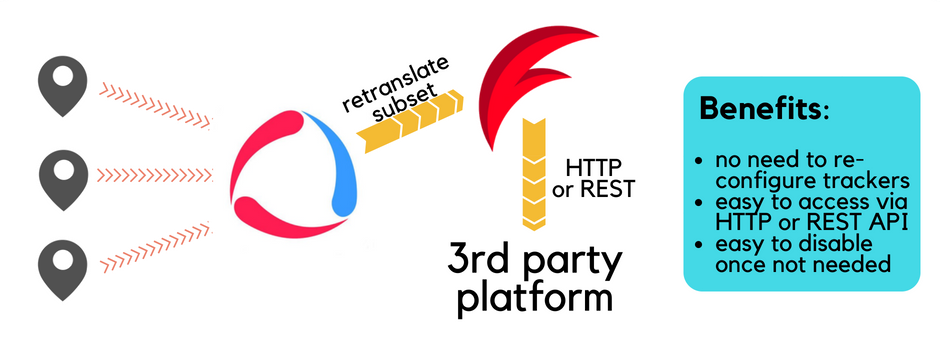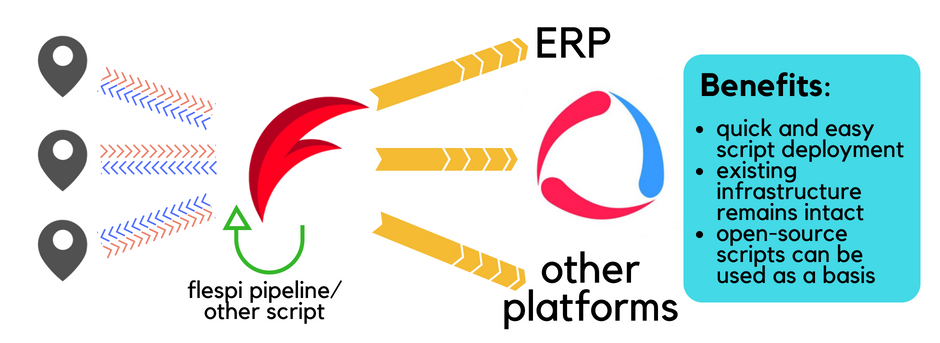Instead of talking about flespi and Wialon capabilities in terms of features, we’ll go straight to real scenarios in which using flespi together with Wialon adds value and helps achieve desired results efficiently.
Integrations to 3rd party platforms/ERP
Rarely can one platform cover all business needs, therefore it is highly demanded to send data from one platform to another. Wialon API may be somewhat rigid and inconvenient for such applications, while flespi specializes in connecting versatile platforms and systems into a single whole with maximum flexibility and ease of implementation.
Let’s be more specific and set the task to send the data from trackers to Wialon and to an ERP. We can approach this task in two ways:
put flespi between trackers and Wialon and then fork the data to Wialon and ERP:
or leave the communication between the trackers and Wialon intact, retranslate messages from Wialon to flespi, and then have flespi forward the data to the ERP via an HTTP stream or API:
Both of the above are viable options with specific traits:
Wialon-before-flespi: This one might be more attractive for solid, long-standing infrastructures you don’t want to disturb. You won’t need to reconfigure the trackers to send to the flespi channel. However, debugging connectivity issues may be a challenge (see below).
flespi-before-Wialon: flespi is a cloud platform with guaranteed 99.9% availability, so you can rest assured that no message will ever get lost due to upgrades or errors. In addition, you will have unified parameter naming for all types of devices in both systems — Wialon and ERP, which may be useful in case the joint use of their data is ever required. What’s more, flespi enables easy device management and diagnostics (see next case).
Device management and diagnostics
If you regularly need to configure trackers remotely, flespi can greatly facilitate the task with its universal device configurator. Delivering a single graphical interface to configure trackers by multiple manufacturers the configurator supports sending commands over the Internet connection and via SMS (you get 10 free SMS each month in the free version of flespi). Bulk device configuration currently requires some scripting on your side and relies on the flespi REST API.
Establishing the connection with trackers and configuring them may not always go smoothly. flespi advanced diagnostic tool — Toolbox — facilitates debugging at every step: establishing a connection, getting messages inside the flespi channel, sending commands to the device, applying setting changes to the device, forwarding data to the third-party platforms.
Note: unlike in Wialon, flespi channel has a dedicated IP:port that accepts messages from devices by the same manufacturer (same protocol). You do not share this IP:port with anyone else and thus can have full control of it.
Getting data from 3rd platforms
It’s not only data from GPS trackers that flespi can aggregate and distribute — it can well be third-party platforms, MQTT-powered IoT devices (e.g. sensors, vending machines, etc.), online services (by truck manufacturers, e.g. fleetboard, scania-fms), and more.
When all this mixture of data types gets into flespi, it will aggregate, store, and provide data in the convenient format to Wialon.
Combining/comparing GPS tracking solutions
You may consider alternatives to Wialon for certain projects and want to compare how different solutions perform. And it would be nice for this testing to not affect the current state of affairs — no switching units from Wialon to other platforms at this stage. Let’s see how flespi can handle the logistics in this case:
Say you have some units on Navixy and some on Wialon. With flespi, you can direct the ones on Wialon to Navixy and vice versa thus having the entire collection of units on both platforms. Now configuring the two platforms in a comparable manner you can see which one better copes with the given tasks.
Another situation is when you want to aggregate units hosted on different platforms on a single map. There’s a straightforward way to do it in flespi:
All platforms send data to flespi either via a retranslator or using a dedicated protocol if supported. flespi aggregates the data and visualizes the vehicles from all platforms in TrackIt — a built-in open-source GPS viewer.
Forking subsets of devices
You may want to send a subset of the Wialon units (e.g. belonging to a specific client) to another platform for additional reporting or analysis. flespi comes handy here since there is nothing you should do in Wialon except setting up retranslation for the units in question.
With such a scheme, once the need to fork the data disappears you just disable the stream in flespi do not worry about any side-effects in Wialon.
Data correction
Even though flespi is primarily a hub juggling the streams of data, it can also be used as a pre-processor before data arrives at its destination (usually a fleet management platform or the like). A perfect example is inspired by the recent GDPR regulation that requires distinguishing between business and private trips and exclude all direct and indirect location data from the latter ones.
The flespi pipeline script processes messages coming to the channel and sends them to another channel that will then forward them to the desired destination.
You can write your own scripts or customize ours (they are open-source) to quickly resolve targeted issues without any surgical intervention on the existing workflow.
Backend for dashboards
Wialon features Sensolator — a nice dashboard to visualize telematics data. However, if you need something not easily achievable with this tool, but know which tool can help you, you can have the data prepared by flespi for further visualization. It means that flespi will serve as a backend for the dashboard and you can use the frontend of your liking. Here are the examples of integration with Grafana and MS Power BI. Note that you can use flespi before or after Wialon in this case:
***
These were just some of the possible situations where flespi makes life easier. We will definitely update this article or publish “part 2” since more functionality is coming soon (e.g. a tool for migration from one platform for another) and more success stories from our clients will follow.
If you are unsure how to better use flespi in your ecosystem and whether to use it at all, shoot us an email with the project details and we’ll give you the tips on how to tackle the task at hand in the most efficient way.
